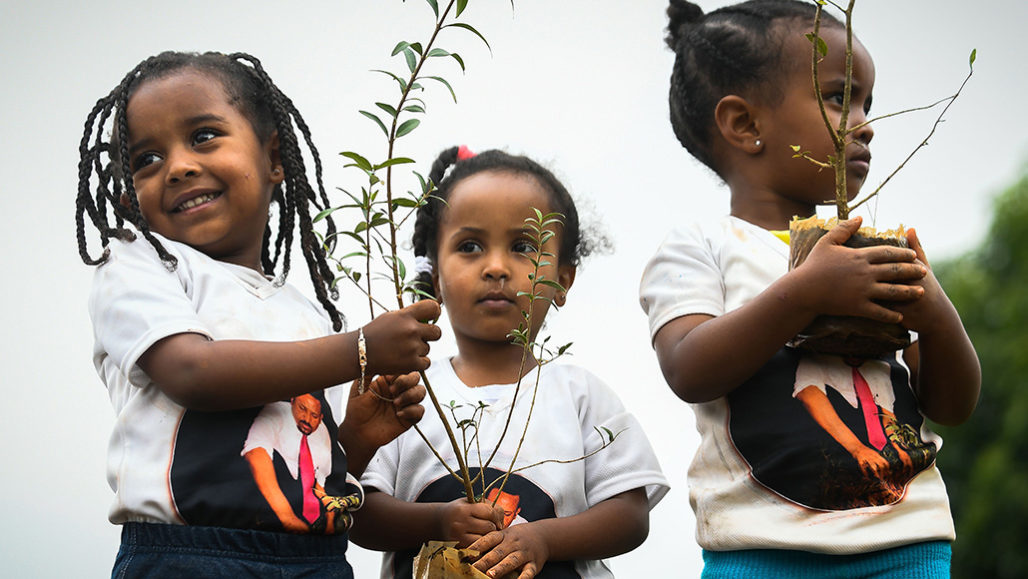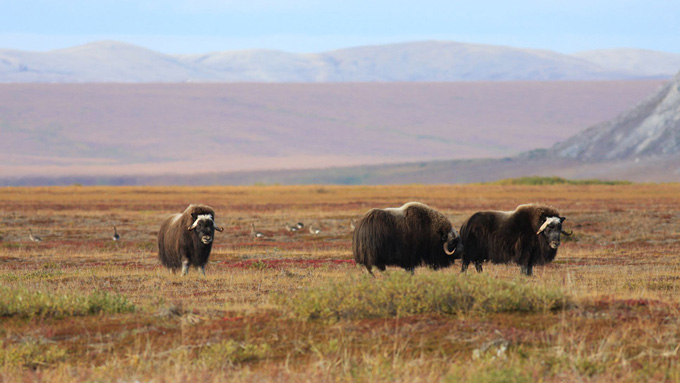5 things to know about the climate-saving benefits of tree planting
Debate erupts over whether one recent estimate of its benefits was greatly exaggerated

An estimate that tree-planting (shown here in Ethiopia) has an astonishingly big potential for curbing climate change has gotten some downsizing by scientists.
MICHAEL TEWELDE/AFP/Getty
By Susan Milius
The idea seemed so catchy and simple. Plant more trees to trap a lot of the planet-warming carbon spewed by human activities. How much? Try some 205 metric gigatons of carbon! (Giga is a prefix meaning billion.) You’d have to plant many, many, many trees. One group of scientists claims the Earth might have enough room for that huge number. However, other scientists now say no.
The big number is “dangerously misleading,” warned Pierre Friedlingstein and four colleagues. Friedlingstein is a mathematical modeler at the University of Exeter in England. This group is not the only one to say the number is bloated.
The debate started with a study in the July 5 Science. In it, Jean-François Bastin and Tom Crowther of ETH Zurich in Switzerland and their coauthors estimated that Earth has as much as 0.9 billion hectares of land suitable for planting new trees. The number came from using pictures of Earth taken from space. Then the scientists used computer programs to find places more trees might grow. Adding up all these places gave an area about the size of the United States.
These new trees should be able to soak up some of the extra carbon dioxide warming the planet. (That extra carbon dioxide comes from such common acts as burning fossil fuels in cars and factories.) Once mature, the new trees could store about one-third as much carbon as humans’ life styles have created since the start of the Industrial Revolution. Or that’s what the team calculated.
That claim caught the attention of a world starved for hopeful news about our warming climate.
Scientists, however, had worries. Big ones. Altogether, more than 70 scientists worked on critiques. Most appeared October 18 in Science (along with a response from Crowther’s team).
Here are five takeaways from the debate, and what it says about the climate benefits of extreme tree planting.
1. Tree planting is not the one big solution for the climate crisis.
Both the critics and the authors of the original paper agree on that statement. The main solution to the climate crisis is to stop releasing greenhouse gases. And action should start as soon as possible.
Burning fossil fuels — coal, oil and natural gas — are a leading source of the carbon released as carbon dioxide. Just don’t release it to begin with, writes Simon Lewis and his colleagues. Lewis is a forest ecologist in England at University College London.
Crowther’s and his team say they agree. In fact, they admit that their paper was not clear about this. In their answer to critics, they call cutting the releases an “urgent need.”
2. Estimates of how much carbon trees can trap might be greatly exaggerated.
Capturing 205 metric gigatons or carbon would be “an astounding accomplishment,” says Joseph Veldman. He is a plant ecologist. He works at Texas A&M University in College Station. However, that 205 sounds far too high, he and 45 other scientists say. A more realistic number, they say, may be only a fifth as high. (More on why later.)
In a separate analysis, Lewis of University College and his colleagues say they should cut the 205 at least in half. Three other responses also said the 205-gigaton estimate looked high but didn’t say by how much.
3. People will probably never choose to plant trees on all bits of “available” land.
The original estimate included tundra and also gaps in far northern forests. However, planting trees there might make climate change worse.
That’s because trees reflect less solar energy than snow, grasses or even bare ground. The ability to reflect energy is known as the trees’ albedo. If trees in these places absorb a lot of the sun’s energy, instead of reflecting it, they could further warm themselves and the planet. Just taking out these risky, snowy northern places would cut 52.8 metric gigatons of from the original July 5 estimate. That cut by itself lowers the original estimate by about a quarter.
Attempting to plant trees in some “available” spots — such as Yellowstone National Park in the United States — could run into fierce opposition. Why? Many people see value in keeping those areas as they are today. Veldman’s group, for instance, cut another 53.5 metric gigatons from the July 5 estimate to leave tropical grasslands as they are. Some of the animals in those ecosystems are “already gravely threatened,” they note. Turning their homes into forests would hurt. Plus, getting rid of a grassland could upset the lives of people who live there now. They might need to find new water sources, places to hunt game or let their livestock graze.

Crowther did not exactly disagree. He just said these decisions were “beyond the scope” of the original survey. His goal had been to show where more trees could grow, not where they should grow.
4. Soil carbon and some other details could matter.
There’s carbon already in soil, even without trees growing on it. For instance, it can come from other kinds of dead plants or animals. Yet Crowther’s numbers did not adjust for this, three critiques noted. Ignoring that soil carbon would make adding trees seem like a bigger change than it really would be.
Critics looked hard at other details too. There’s already carbon stored in the living nonwoody plants, such as grasses, already growing on land. The estimate did not account for that either. That gap too could have made the July 5 estimate too high, critics said.
5. Planting trees could still be a good thing as long as it’s done thoughtfully.
Perhaps epic tree planting won’t have impacts as big as some had hoped. But even if that July 5 estimate is 90 percent too high, planting trees in appropriate places could reap big benefits.
Indeed, tree planting has long been recognized as valuable, notes one team led by Alan Grainger. This global-change geographer works at the University of Leeds in England. At least the Crowther paper is calling fresh attention to the idea, his team notes.







